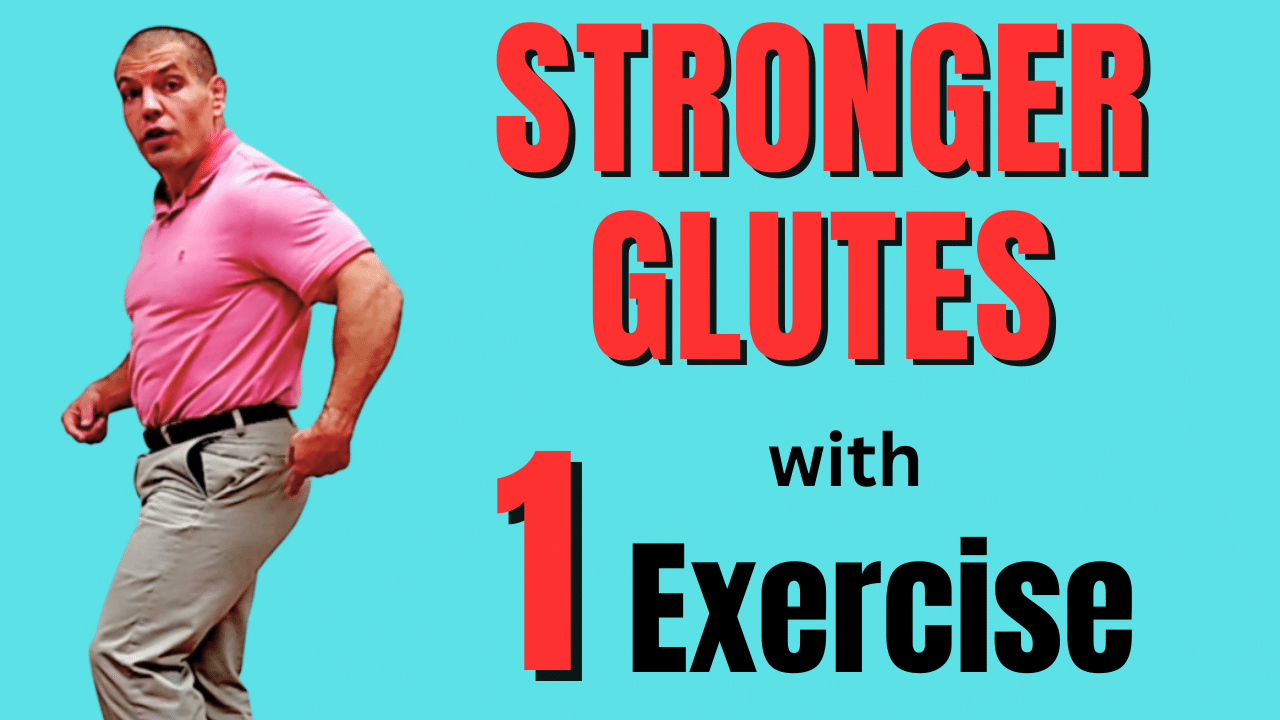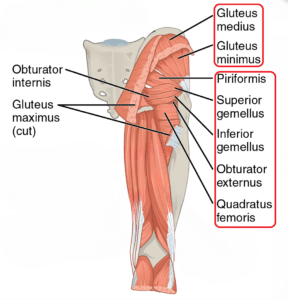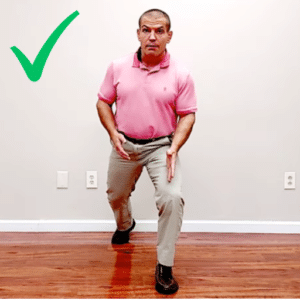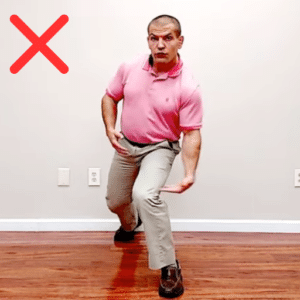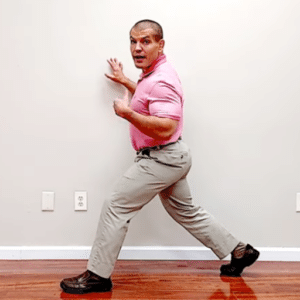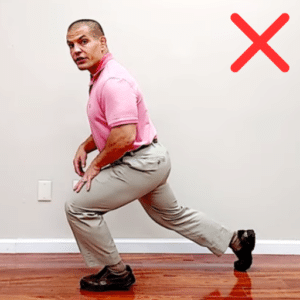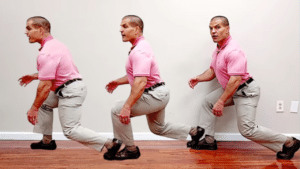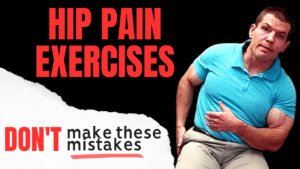What's The Best Glute Strengthening Exercise?
If you want to strengthen your glutes but don't have a ton of time available, watch this video to learn the single best glute strength exercise to get the most benefit from the workout time that you have available.
What Qualifies As The Best Glute Strength Exercise?
There are so many different glute strengthening exercises that it can be overwhelming.
Some common glute strength exercises include:
- squats
- lunges
- deadlifts
- straight-legged deadlifts
- bridges
- hip thrusts
- leg raises
...and others.
Most videos or articles that study the best glute strengthening exercise use research-based terms which are based on something called the Percentage of Maximum Voluntary Contraction (% MVC).
But the things that research studies don't take into account is:
Just because you can activate a muscle with a certain exercise doesn't necessarily mean that it's going to translate into helping you in everyday life.
So whenever I prescribe someone an exercise, I first ask "What's the benefit?"
What does the person want to get out of doing glute strength exercises?
For most people, that's not getting a certain percent MVC.
Most people want to be able to walk or run better, go up and down stairs, get up from the floor, squat, or maybe just look better in a pair of jeans.
Whatever your goal is for getting stronger glutes, the end goal is going to dictate what the best exercise is for you.
How Do You Use Your Glutes In Real Life?
Now if you think about the way that most people use their glutes in everyday life, it's to:
- push off when walking or running
- to get up from the floor
- to go upstairs
So to be the "best" glute strength exercise, it should use your glutes in a way that you functionally them in your everyday life.
And for that reason, I think the lunge is the best glute-strengthening exercise.
That's not to say that those other exercises aren't good.
But if you're short on exercise time and you want to maximize your benefit out of the exercise time you have available, the lunge is probably the best exercise to do that.
Why Is The Lunge The Best Glute Strength Exercise?
The lunge is the best glute strength exercise because it activates all three of your gluteal muscles.
We talk about the glutes as if they're one thing, but you actually have three gluteal muscle:
- gluteus maximus
- gluteus medius
- gluteus minimus
The Gluteus Maximus
The gluteus maximus is the big muscle that most people think of as their butt muscle.
The gluteus maximus is a hip extensor.
The movement of hip extension can mean is moving your leg backward into a position of hip extension (behind your body).
Or, the movement of hip extension can also mean moving your hip from a position of hip flexion back to a neutral position.
The Gluteus Medius and Gluteus Minimus
The other two muscles, the gluteus medius and gluteus minimus, are more over the side of your hip.
Those muscles are hip abductor muscles.
Abduction means moving a limb, in this case, your leg, away from the midline.
But the way that we use our hip abductors in everyday life is NOT for hip abduction.
Rather, we use the gluteus medius and gluteus medius isometrically to balance on a one leg and prevent the pelvis from dropping when walking, running, or when you're going up and down stairs.
The lunge addresses helps strengthen all 3 glute muscles the way you would use them in real life.
How The Lunge Strengthens The Gluteus Medius and Gluteus Minimus
The squat is a great exercise, but because you're using both legs, you're balanced from side to side.
You don't have to control yourself in a side-to-side plane.
So while the squat is a great exercise for strengthening your gluteus maximus, it doesn't mimic the balance aspect that you need for the way that you use your glutes in real life.
How To Do The Lunge (Front View)
Take a fairly large step forward.
As you're going down into a lunge, make sure that your knee is alignment with your toes.
For most people, the natural instinct is for your knee to cave inward into a position of hip adduction (toward midline)
In order to counteract this, you need to activate your gluteus medius and gluteus minimus (and to some extent your gluteus maximus as well).
This turns your knee outward in a motion of combined hip abduction and external rotation.
Then, no matter how far down you go, make sure you maintain the hip abduction and don't allow your knee to go inward.
What If I Have Knee Arthritis?
Many people who have knee pain or knee arthritis may think, "Well, I can't do a lunge."
The truth is though, almost everybody can do a lunge; it's just a question of how deep of a lunge they can do.
So if you have knee pain when doing lunges, then only go as deeply as you can without pain and with proper technique.
So if you start noticing as you go down farther that your knee starts coming inward, stop at that point because you're no longer using correct technique.
How The Lunge Strengthens Your Gluteus Maximus
From the side view, you can see more of the hip extension component of the lunge.
When doing a lunge, your back leg is in a position of hip extension.
However, it's the front hip that's doing the movement of hip extension.
It's moving from a flexed position towards more of a neutral position, like you would do if you're getting up from the floor.
When you're doing a lunge, you use both your quadricep muscle as well as your gluteus maximus to help control the up and down motion.
The more forwards you put your weight toward your toe, the more of a quad-dominant lunge this becomes.
If you're trying do the exercise to strengthen your glutes, that's not necessarily what you want.
The more quad force you use, the more compression force it puts down on your knee. That can create knee pain such as patellofemoral pain, knee arthritis pain, or patellar tendonitis.
So if you're looking strengthen your glutes by doing a lunge, you want to keep your weight more on the heel.
You should be able to pick your toes up if you've got enough weight on your heel. (Make sure you're standing by something for balance when checking.)
You want to keep your toes on the ground when you're actually doing the exercise. However, if you can't pick your toes up off the floor, then you probably have too much weight on your toes.
So stand by something for balance, make sure you can pick your toes up off the floor. If you can't, shift your weight a little bit more toward your heel.
You should have a fairly wide stance for this exercise because a narrow stance is going to put your weight too far up on the toes.
Get a fairly wide stance and then come down as far as you can comfortably, whether that's just partway down or whether it's all the way down to the floor.
If a bodyweight lunge is too easy for you, you can start adding dumbbells to add further resistance.
HYPATA 25 lbs Pair Adjustable Dumbbell, ...
$169.99 (as of July 26, 2024 09:57 GMT -05:00 - More infoProduct prices and availability are accurate as of the date/time indicated and are subject to change. Any price and availability information displayed on [relevant Amazon Site(s), as applicable] at the time of purchase will apply to the purchase of this product.)The Walking Lunge Is An Even Better Glute Strength Exercise
Now another more functional way to do the lunge is more of a moving or walking lunge.
That's what we do when we're walking or when we're running:
We alternate using one leg after the other.
We don't do all the repetitions on one leg and then all the repetitions on the other leg.
The Walking Lunge Exercises Your Gluteus Medius and Minimus
The other aspect of the walking lunge is as you go to take a step to the next leg, you have to balance yourself over the first leg.
This which helps strengthen your gluteus medius and gluteus minimus a little bit more as well as helping your balance.
How to do the walking lunge:
- Take a step forward
- Get your weight on the heel of the front foot
- Go down as far as you can comfortably, whether it's halfway or all the way.
- Then push back up through your heel and take a step.
- Repeat
So the walking lunge is actually a better, more functional way to do the lunge and is probably truly the best glute strength exercise.
Conclusion
Now again, that's not to say that there aren't other great glute exercises to do, and it is often good to include variety in your workout: doing squats, hip thrusts, bridges, single-leg balance, single-leg balance with hip abduction, and clamshells are also great glute strengthening exercises.
Learn common mistakes with those exercises in this post.
However, if you're looking for just the number one best, most time-efficient exercise to strengthen your glutes, it's probably the walking lunge.
Need more help to strengthen your glutes?
If you're in the St. Louis area and you need more help to strengthen your glutes to prevent or treat back pain, hip pain, or knee pain, we'd be happy to help you.
Just tap the button below to request an appointment with one of our specialists.
Additionally, here are some other posts about leg strengthening exercises that you might enjoy:
7 Tips To Stop Knee Pain From Lunges
Best Leg Strengthening Exercise For Seniors
Strengthen Knee With Exercises At Home
4 Ways To Stop Knee Pain With Squats

